
Banner image courtesy of Marc Vaillant
Trioceros johnstoni Care Summary
The Trioceros johnstoni Care Summary distills the most important aspects of husbandry care into an easily referenced handout. But chameleon care is, unfortunately, much more involved than can be presented on a summary sheet. Therefore, you may use this sheet as a reference and return to this page where we will go over each and every aspect that is on the summary sheet in detail.
Trioceros Johnstoni (Johnston's Three Horned Chameleon) Natural History
In the highlands of the mountain ranges that run down the borders of Uganda, Congo, Rwanda, and Burundi, from 1000 to 2400 meters above sea level we encounter a colorful three horned species, Trioceros johnstoni. Across this wide range we end up with distinct color forms identified by their location. The most commonly seen are the Bwindi and the Rwenzori. The Bwindi form is named from the Bwindi Impenetrable Forest in the region where they come from. This forest is famous for its mountain gorillas and you can get a feel for the area by the numerous documentaries on the gorillas. The Rwenzori form is named after the mountain range where they are found. Both the Rwenzori and Bwindi forms are found in both Uganda and Congo. The Bwindi form is distinguished by tending towards the blue colors while the Rwenzori form includes red. The Rwanda and Burundi forms are less colorful.
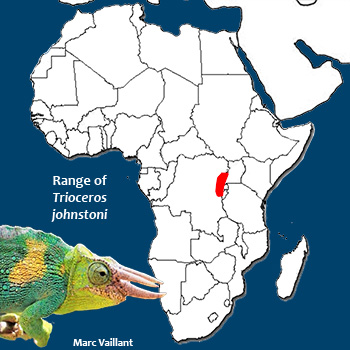
First Hand Field Account


The Bwindi Impenetrable Forest in Uganda. This is the habitat of Trioceros johnstoni. Image by Marc Vaillant
Marc Vaillant is a wildlife, and especially reptile, enthusiast who has travelled around Africa for both work with the UN and pleasure. On a recent trip to Uganda he visited both Mt. Elgon and the Bwindi Impenetrable Forest. He shared this about his experience with T. johnstoni:
“These were found on the edge of the Bwindi Impenetrable Forest Reserve. We only found two individuals (two males boasting rather different coloration).
Sadly, I’m not sure about the exact altitude, but this is obviously also an area that experiences significant temperature gradients. Rainfall and mist are also the rule rather than the exception.
While we were mostly there to observe the famous Mountain Gorillas, johnstoni was naturally also high on the list. We immediately enquired about chameleons among the locals. Unlike around Mount Elgon, the communities here seemed more warry about chameleons. They seemed to fear them and kept their distance once we found one. Regardless, a bunch of friendly kids took us on a walk along a dirt road next to their village, explaining that it would be a good spot for chameleons. Surely enough, we quickly found the two individuals you see in the pictures, only a couple hundred meters from one another. Both were found mid-day in low trees/bushes on the edge of the road. Both seemed to be enjoying some rays of sun in what had otherwise been a cold and misty morning.
Interestingly, some locals told us that the chameleons of the area were in decline. They cited an increase in predatory crows/ravens as the responsible cause. Whether there is any truth in that, I don’t know.“
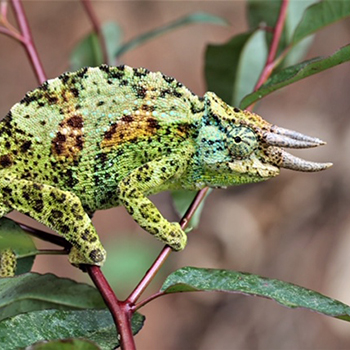
A Male Trioceros johnstoni. Bwindi locale. Image by Marc Vaillant

A Male Trioceros johnstoni. Bwindi locale. Image by Marc Vaillant
Captive Husbandry
Jurgen Van Overbeke is a chameleon breeder in Belgium who has extensive experience with a wide range of chameleon species. He offers his insight into breeding and keeping Trioceros johnstoni.
“Trioceros johnstoni is one of my favorites. With its color and horns it is hard to imagine a better combination. Not only are the males colorful with horns, but the females are beautifully colored as well.
The care conditions are standard for this higher elevation species. Mild day time temperatures that don’t go above room temperature, but ensure they have a basking light if they choose to warm up. They definitely need that strong nighttime drop. Keep them in a densely planted terrarium and do not keep them together. This species does not have much of a tolerance for each other.
For hydration I gave them around three hours of fogging in the very early morning before the lights came on and a 15 minute misting in the later afternoon. I then run a dripper just to make sure nothing is missed.
I provide them with natural unfiltered sunlight during the summer and a T8 Reptisun 5.0 during the winter. They are sensitive to supplementation so I give calcium once per week during summer and calcium with vitamin D3 once per week in winter.
Breeding is not complicated. Gestation is three months and the female lays quite large eggs that hatch in about 100 days when incubated around 18-21C (upper 60s F). Young females lay 12 eggs and larger females can lay up to 18 eggs. One clutch per year is standard, though I have a two clutch year before.
The babies hatch out surprisingly large and are easy to raise up.”

Listen to Jurgen introduce us to Trioceros johnstoni
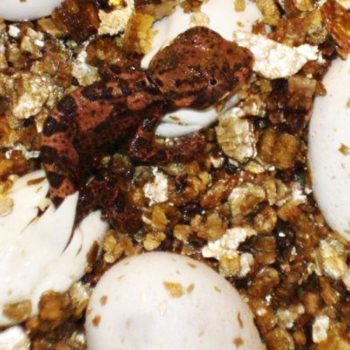
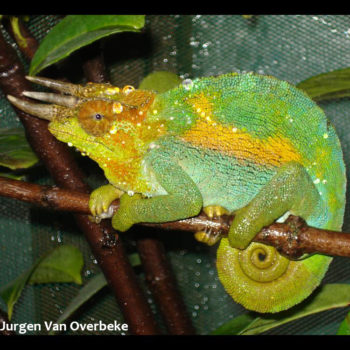

Cage Type and Size

The minimum cage size for both males and females that allows the creation of a suitable environment is 2’ x 2’ x 4’ tall, but males, especially, get to a size where a wider cage would be appreciated. Their desire for higher humidities than are found in human homes suggest a hybrid cage with solid sides be considered.
House males and females separately.
Johnston’s Chameleons are housed in the Forest Edge style cage interior. A forest edge cage provides the open basking area and the densely leafy area where they can retreat, hide, and feel safe. This retreat area is critical for their well being. Notice in the cage shown here that there are distinct open and leafy areas. This is what a Forest Edge cage will look like. The most overlooked aspect of a chameleon cage is the visual retreat where the chameleon can hide away when they desire privacy. This is critical for creating an effective chameleon environment.
Ambient Temperature
The Johnston’s Chameleon comes from high altitude equatorial mountains . This means that the seasonal fluctuations are between wet and dry seasons rather than hot and cold summer/winter. Thus the annual temperatures that the Johnston’s Chameleon encounters are in the mid 70s during the day down to low 50s at night. Care must be taken to not expose them to temperatures in the high 80s or 90s as they will experience heat stress. While it seems they are less dependent on deep nighttime drops like Jackson’s Chameleons, drop them as close to the 60s and 50s as possible.
Basking Temperature
A low nighttime temperature is a requirement for a healthy Johnston’s Chameleon. But your chameleon will need to warm up in the morning to get a good start on the day. In the wild, chameleons look to the sun rise and bask until their body temperature is sufficient for optimal hunting, digestion, and general function. For Trioceros johnstoni, a basking bulb in the low 80s will be sufficient.
In captivity we give them this warm up through a basking bulb which is usually an incandescent bulb shining on their basking branch.
We need to be careful when setting up this bulb as it is very easy to burn your chameleon. Chameleons do not seem to have a keen sense of when they are being burned. And this is the reason that we will be encouraging basking bulbs to be mounted above the cage instead of on the cage top. The closer to the bulb, the more difference in temperature can happen in an inch. The ideal scenario is to have a higher wattage bulb further away. This produces a wider, and “gentler” heated area that has no burn risk.
Your main purpose is to set up a safe temperature to start with and then you will adjust the bulb distance based on your chameleon’s behavior. If your chameleon shows the following behaviors, bring the bulb closer
- Huddling under the bulb for more than 30 minutes
- Hanging from the top screen panel under the bulb
- Remaining dark and lethargic. After basking, they should take on resting colors.
The issue with relying on behaviors as a signal to move the bulb further away is that they generally are physical damage to the body such as gray burned areas, open wounds, and melted back spines. And it is concerning how long this kind of situation goes on before the keeper realizes what is going on. So this means the chameleon is basking even though it is too hot. Thus it is better to start low rather than high. The low 80s F is a safe range to start off with. But always do the back of the hand test and watch behavior.
Johnston’s Chameleons are cooler weather chameleons so err on the cooler side. This is especially important when using a solid side cage for humidity purposes. Solid side cages will also allow heat to build up.
Humidity
Johnston’s Chameleons experience high humidity nights and mid humidity days. A nighttime humidity of 80% to 100% and then a drop to 60-80% during the day will allow them to engage in their natural humidity cycle. The exact numbers are not critical. There are two important aspects. 1) during high humidity times keep the air moving. Often cages are modified to enclose sides to impede airflow so a fogger can increase humidity. In this case have a ceiling fan or computer fan mounted to the top of the cage make sure that the “fog bank” circulates. Stagnant air, regardless of how humid, is unhealthy. 2) All surfaces must be dry during the day. Even if humidity is higher than the numbers listed, if the surfaces are dry then there shouldn’t be a health problem. It is when surfaces, such as the branches the chameleon climbs on are constantly wet the feet get sores and bacteria/fungus/mold is able to take a hold.
Lighting
Johnston’s Chameleons take the standard bright light that we put on our chameleon cages. A quad High Output T5 fixture the width of your cage with four 6500K fluorescent bulbs will light a 4’ tall cage nicely. A 12 hours on and 12 hours off cycle is used. When using bright lights be aware of heat build up. I suggest using a rack system or somehow elevating the lighting fixture above the cage to allow the heat to escape before going into the cage.
Your chameleon will need it bright inside his cage. One of the most common cage issues, behind no hiding place, is insufficient light where, when you look at the cage, the chameleon looks like it is in a cave with a miner’s lamp. A bright cage will allow plants to grow and your environment to be vibrant.
Natural sunlight through a window is excellent, but use with caution. Sunlight tends to be too powerful and could overheat your chameleon. Be careful with sunlight. Note that sunlight filtered through a window will lose all UVB.
UVB

The most effective and reliable way to producing UVB for your chameleon is with linear T5 high output fluorescent tubes.
Presently we are targeting an UV Index of 3 at the basking branch with a maximum of UVI 6 to allow for sufficient vitamin D3 synthesis. Presently, we do not have specific tests done on the Johnston’s Chameleon to determine what UVI is required to fully calcify their eggs. As they come from roughly the same elevation as the Jackson’s Chameleon, that is the first reference we will use to bridge us to when specific Johnston’s tests can be conducted.
UVI 3 is generally what you can generate using a T5 HO Arcadia 6% or Zoomed Reptisun 5.0 in a single bulb reflector at a basking branch 6″ inches from the light going through a standard 70% transmission screen cage top panel. (70% transmission screen is common and is used on Dragon Strand, ZooMed, ExoTerra, and Leap cages) These numbers are all general estimates as each reflector will have it’s own reflection properties and each bulb will have different strength depending on age. Luckily, this does not have to be an exact value. Ballpark is fine!
UVB Meters are an expensive piece of equipment, but are a valuable tool in setting up your chameleon’s environment. If you can get one – do it!
Setting up the lighting and hydration schedule
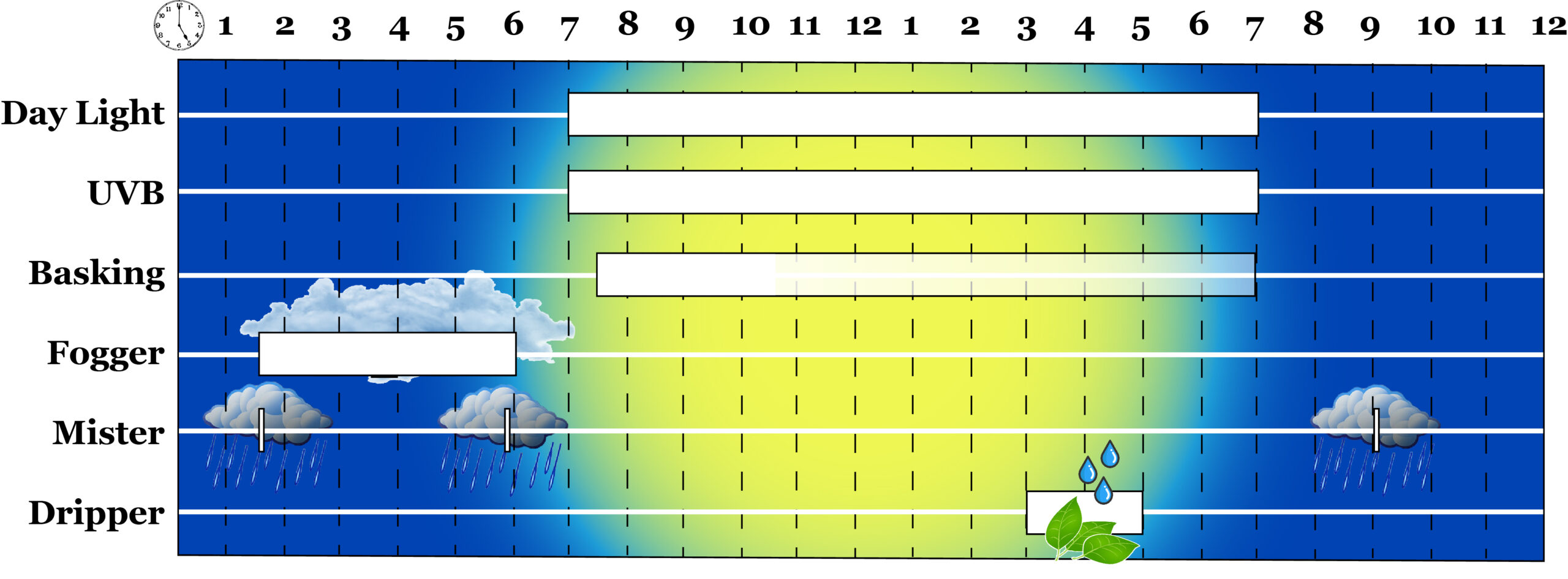
When we set up our daily schedule we are attempting to replicate the wild conditions that the chameleon has grown to expect. Let’s start at midnight.
Midnight: At midnight the chameleon has been asleep for many hours. It is dark and, although the moon waxes and wanes, chameleons will seek out dark places to sleep. They see light of all colors just fine and any light can disturb their rest.
Early Morning: As the early morning progresses the humidity rises. Fog banks can start to form and the chameleon is breathing in moist air. This high humidity forms an important part in their natural hydration. To simulate this, we turn ultrasonic humidifiers on around 1:30AM. The fog from the humidifiers tends to bounce off of surfaces and roll out the cage so we run the misting system for a couple of minute to coat the cage in a layer of water. This helps the fogger be more effective and the fog tends to stick around. The fogger go from 1:30 to 6:00 in a 30 minutes on and 30 minutes off pattern. This is to protect against too much fog. This is wise when you have closed in three or more sides of your cage to retain humidity. If you have a completely screen cage then you may leave it on the entire time. This all is done so the chameleon can breathe in the humidity.
Our purpose is to have them breathing in a humid environment so they do not lose moisture from breathing. How much and how often you run your fogger or humidifier depends on how much ventilation your cage has and the ambient conditions. So expect to run the fogger for different schedules depending your seasons.
Dawn: Just before the lights come on the misters are run for another couple of minutes to make sure that when the chameleon wakes up it wakes up to surfaces covered in “dew”. This is a natural source of water for them even in their dry season. Once the dew is laid down the lights can come on.
Around 7AM the daylights come on. This can include the UVB light if they are the same fixture. If they are separate fixtures then save turning the UVB light on to correspond to when the basking bulb is switched on. I like to leave the daylight bulbs on for 15 or 30 minutes to give the chameleon a chance to leisurely lick whatever dew they want. I then turn the basking bulb on so they can warm themselves up.
Morning: As the ambient temperatures start to warm there is no longer the need for a basking lamp and it is shut off. The actual time that the basking lamp is on will depend on your chameleon’s needs. Watch the behavior. If the routinely get the warmth they need in 30 minutes and then climb away with content colors to hunt then reduce your basking time to that time that they make use of the warmth. If they need the warmth for a longer period of time then leave the basking bulb on longer or consider increasing the temperature slightly. Watch your chameleon and they will tell you what they need. With a screen cage there is usually no issue leaving it on for the day, but if your ambient daytime temperatures start getting to the high end of their comfort, you can shut the basking lamp off.
Afternoon: Sometime during the day (I start at 3PM) start your dripper. This is a backup hydration strategy just to make sure they have enough water. While it is true they do not have drippers every day in the wild during the dry season, they also are not needing to reconstitute dry calcium powder on all their feeders. The advantage of running a dripper is that it is completely optional for them and, as a bonus, it also allows you the opportunity to ensure your plants get watered. Place it above a different plant each day and through out the week, all plants will get watered. It is not critical when you start the dripper. In this schedule I have it in the late afternoon so that the chameleon can rehydrate before the evening rest. I suggest starting the dripper an hour or so after feeding them so they can replenish what they need. In the wild, their food is a major source of hydration. We mess that up a bit with our powders and a dripper is a way we make up for that. Ideally, the chameleon will have gotten enough hydration from the moist night air, morning dew, and food items. I consider it a success when the chameleon ignores the dripper and an early warning sign when he drinks from the dripper.
Dusk: Once the chameleon settles in and goes to sleep I like to have a couple minutes misting just to set up the night humidity.
You’ll notice there are no daytime mistings. Although this is common in chameleon husbandry, and I did it myself, I have transitioned my mistings to the sleep hours. Chameleons have been consistent in their communicating that they do not like being sprayed. I have given up deciding I know what is best for them and started to listen to them. The night fog, morning dew and the afternoon dripper provide the necessary hydration in a natural way. With those provided there just isn’t a need to force them into a shower in the middle of the day. That said, misting during the day has been the standard for decades and if that is what you are comfortable with or what your breeder has told you to do then follow those instructions for as long as you are taking guidance from them.
Feeding

The job of the babies is to grow as fast as possible so as babies they should be fed as much as they can eat.
You want to reduce the calories they consume once they start growing out instead of growing long. Once they are adult size, their growth will slow and their food will go to increasing the size of their fat pads. The trick is to know when they are adult size because each chameleon grows at a different pace. Johnston’s Chameleons achieve sexual maturity at about 12 months old so it would be sometime after that. This will be the time where you will have to make a judgement based on what you see. Getting the exact point where they have stopped growing quickly is not necessary so there is not need for stressing on this issue. An obese chameleon can easily be put on a diet and brought back to health.
When you have decided they are at their adult size, you can consider reducing the feeding to 3-4 appropriately sized food items every other day. The exception is once the female is gravid. At this point she is developing eggs and you can feed her as many richly gutloaded insects as she will eat. As the eggs get larger they will take up more of the body cavity and she will naturally decrease how much she eats. Once she has laid her eggs then continue on with feeding her as much as she will eat until a week or so later.
There is often a complaint about chameleons refusing food or becoming very picky. The #1 reason why chameleons become picky eaters is because they are not hungry. We tend to feed our chameleons too much and once they are stuffed they only eat when it is their favorite food. If your chameleon refuses all but their favorite feeder then skip a meal and offer them one feeder of the standard type you wish them to eat again the next meal. You may skip up to a week without worry. In fact, two weeks is still not dangerous. As long as you offer the regular boring meal every couple days you will find their hunger point when it is reached.
Supplementation
Introduction to Supplementation and Johnston’s Chameleons
Trioceros johnstoni are especially sensitive to over-supplementation. They are prone to develop edema when the supplementation produces an imbalance. Therefore we must be extra careful to remove the fat soluble vitamins from the diet as much as is possible. What component of our supplementation powders causes this reaction in them is unknown. I actually prefer to supplement only with calcium and bee pollen with UVB as just a little bit of even Repashy Calcium Plus LoD caused a reaction in one of my Johnston’s Chameleons.
The Chameleon Academy Supplementation Approach
The supplementation routine chosen for our recommendation is designed to use be as close to nature as we can with what we know now. According to what we (think we) know, chameleons do not get a significant amount of vitamin D3 or vitamin A in their diet. Vitamin D3 comes from UVB and Vitamin A comes from…somewhere. We are still working out those details. Thus it is simple to know how to remove dietary D3. We provide sufficient UVB exposure. Removing preformed vitamin A from the diet is a bit tricky as some breeders can have generations of healthy babies with no dietary preformed vitamin A, while others will encounter birth defects, low survivability, and eye health issues unless preformed vitamin A is added. Thus, vitamin A remains a major hole in our understanding of chameleon nutrition. The most obvious suspect is the carotenoids within the gut loaded insects. Many animals use these to create vitamin A. A study done showed that beta carotene, the most commonly converted carotenoid in humans, was not, at least in isolation, converted by panther chameleons. More study will have to be done to determine which of (or if) the other carotenoids are being converted. But there is no known consistent source of preformed vitamin A in the wild chameleons’ diet. So it has to come from somewhere.
Prerequisites
The Chameleon Academy supplementation schedule relies on 1) the presence of UVB in the strength of at least UV Index 3 for D3 conversion and 2) a rich gutload of feeder insects.
The Pre-Requisite of UVB levels at UV Index 3
The Chameleon Academy Supplementation Routine relies heavily on the chameleon producing its own Vitamin D3 from UVB exposure. This uses the natural body mechanisms designed for this purpose. This is highly desirable as vitamin D3 is fat soluble and can be overdosed and can cause serious health issues. Going through the natural process has a natural cut off where the body will stop producing D3 when it has enough. It maintains optimal levels in a way that we have no possible way of replicating.
The Pre-Requisite of Gutloaded Feeders
In all instances, feeders should be richly gutloaded with a variety of fruits and grains. They must be cared for with proper heat and even, we are learning, exposure to UVB. This creates the most healthy, nutrition packed feeder for your chameleon. Supplements are just that – a supplement to a properly gutloaded, healthy feeder insect. Supplements will not make up for a poorly fed feeder insect. Every supplementation routine requires a properly gutloaded feeder insect.
Supplementation for Every Feeding
Calcium will be given every feeding. Calcium is all around our world. Chameleons take in calcium through diet so this is the natural way they get it.
The every feeding supplement should be, at least, plain calcium. The addition of bee pollen in a 50/50 mixture with the calcium can add to the nutrition of your feeder. This can be fed every feeding. Bee pollen does not stick on its own and mixing bee pollen powder with calcium powder or crushing up bee pollen granules with calcium powder will produce an effective (and well tested) every feeding powder supplement. A supplement such as Arcadia EarthPro-A already is a mix of calcium and bee pollen with carotenoids and B vitamins.
Supplementation Once A Month.
Currently, there are tests going on to determine whether we need to give preformed vitamin A in addition to feeder gutload. And, if so, how we can do so without triggering edema. At this point, a monthly dusting of a supplement with 100k IU/lb or less of vitamin A could be given. (examples: Repashy Calcium Plus LoD or Reptivite with D3)

A nutrition regimen consisting of Calcium, Bee Pollen, a UV Index of 3, and richly gutloaded feeder insects will provide nutrition for a Johnston’s chameleon over each of its life stages.

Supplementation is just one component of the nutrition strategy. You must also have both a UV Index of 3 and feeder insects that are richly gutloaded for the Chameleon Academy supplementation regimen to work properly.
Navigation
This seminar is part of the Johnston’s Chameleon Profile.



